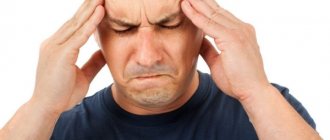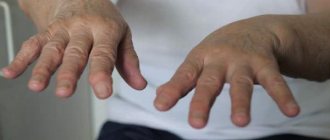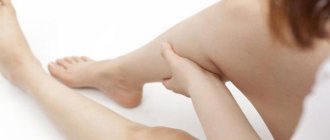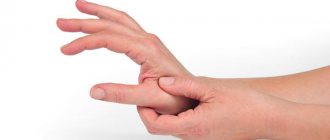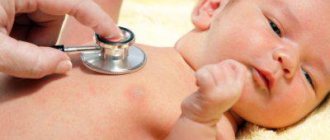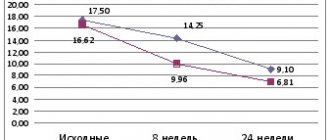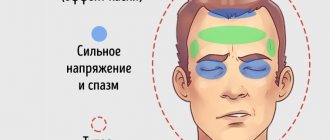You didn’t manage to pick up a pencil the first time, awkwardly brought a cup of coffee to your mouth, and you also didn’t succeed in sewing on a torn button—you never got the thread into the eye of the needle. And the culprit was the treacherous shaking of the hands, scientifically speaking - a tremor that more and more often puts you in an awkward position. In order not to be an involuntary prisoner of this physical illness, it is necessary and possible to fight it. Your doctor may prescribe medications for hand tremors. But first you need to find out the reasons for the trembling of your limbs - after all, the tactics and strategy of treatment, including medication, depend on this.
Why are your hands shaking?
There is an opinion that hand trembling syndrome is the prerogative of only frail old people and experienced alcoholics. Alas, this is just a myth. Tremor, manifesting itself to a greater or lesser extent, currently poisons the lives of many people, regardless of their age, gender, occupation and lifestyle. Moreover, this symptom appears suddenly and can disappear just as suddenly or remain for a long time. The phenomenon, of course, is unpleasant, but the most important thing in this situation is to find its cause, and then select remedies for hand tremors.
Among the causes of trembling limbs, doctors note:
- physical fatigue: due to prolonged hard work, the muscles become overstrained and begin to contract involuntarily;
- emotional overload: stress, strong excitement, irritation, nervous excitement;
- hormonal changes in the body: in this case, hand tremors can be observed in adolescents;
- hypothermia or overheating of the body;
- side effects from taking certain medications;
- abuse of coffee, strong tea, narcotic or toxic substances, as well as strong alcoholic beverages.
These reasons are called physiological. In this case, hand tremors go away as soon as the person rests, calms down, or gets into healthy physical shape. Medical (pathological) reasons are much more serious:
- cervical osteochondrosis;
- neuralgic pathologies, including Parkinson's disease;
- diseases of the thyroid gland, kidneys, liver;
- pathologies of the spinal cord or brain;
- problems in the functioning of the musculoskeletal system.
With these and other similar medical diagnoses, it can be difficult to cope with hand tremor, but the doctor will still be able to select a medicine for hand tremor, which will be part of complex therapy.
Overdose
Possible consequences of an overdose of Anaprilin include the following symptoms:
- dizziness;
- severe decrease in pressure;
- slow heart rate;
- heart failure;
- bronchospasms;
- cyanosis of the extremities;
- breathing disorders.
Help measures:
- gastric lavage;
- purpose of sorbents;
- infusion of plasma substitutes;
- administration of Epinephrine, Dopamine;
- taking cardiac glycosides (for impaired heart function);
- use of Atropine, Diazepam;
- use of temporary pacemakers;
- antiarrhythmics (for abnormal heart rhythm).
Treatment
The easiest way to deal with hand tremors is those caused by physiological or psychological reasons. You just need to normalize your emotional and physical state. True, it happens that there is no time for this, and you need to look decent here and now, no matter what.
First aid for tremors from emotional overstrain is light sedatives based on herbal ingredients: valerian tablets, phytosedan, persen, novo-passit, dormiplant. They can also be taken before any event that could potentially trigger stress, thereby intercepting the tremor symptom before it occurs. These anti-tremor sedatives are available without a prescription.
For more complex cases of tremor, drugs from other pharmaceutical groups are suitable:
- tranquilizers – block feelings of anxiety, prevent panic attacks, stabilize the functioning of the nervous system. Valium, Lorazepam, Frizium have these properties;
- inhibitors – fight nerve pathologies, enhancing the transmission of nerve impulses. These are drugs such as Pyrazidol, Phenelzine, Neptazan.
- benzodiazepines - affecting the central nervous system, they reduce anxiety, have an anticonvulsant and relaxing effect. This group of drugs includes Nitrazepam, Midazolam, Clorazepate.
- anticonvulsants – eliminate muscle spasms and inhibit processes in the central nervous system. This can include Acediprol, Hexamidine, Primidon.
Important! You cannot choose tablets for hand tremors on your own. The drug must be prescribed by a doctor, based on the symptoms of the pathology and its causes.
Folk remedies for treating hand tremors
Traditional medicine can also offer sedatives for tremors, which advises preparing infusions of sage and motherwort, rose hips and mint, St. John's wort and lavender. 2-3 tbsp. spoons of dry herb should be poured with a glass of boiling water and left for 2-3 hours. Take a third of a glass 30 minutes before meals.
Medicine for tremor can be not only in the form of tablets or infusions and decoctions. Physiotherapy, hydrotherapy, and treatment with bees and leeches provide a good therapeutic effect. The doctor decides how to reduce tremor in each specific case after diagnosis. Seeking medical help must be timely, otherwise it will be difficult to predict the outcome of treatment.
Source: golmozg.ru
Nerve sedatives
It is necessary to take a very thoughtful approach to treatment with medical sedatives for nerves. Some medications can cause tremors.
And incorrect treatment regimens (for example, Dysport or Botox) can lead to the opposite effect. To treat increased hand tremors, non-selective beta blockers (propranoline, anaprilin) are used. Anaprilin is prescribed 40-320 mg per day in 3-4 doses.
Hexamidine also has a calming effect (from 62.5 to 250 mg per day). Severe intention tremor is treated with clonazepam (2 to 6 mg per day). Nadolol (Korgard) is considered especially effective.
The anti-seizure drug Primidone (Misolin) will reduce the intensity of the tremors. Carbonic anhydrase inhibitors are used (metazolamide, acetazolamide, diacarb). If medications are ineffective, patients are prescribed benzodiazepines (Xanax).
Surgical treatment (stereotactic thalamotomy) is used for tremor that is highly resistant to medications, which seriously disrupts the patient’s life (inability to eat independently, etc.). In this case, unilateral surgical intervention is performed and the symptoms of tremor are reduced.
Symptoms:
Tremor is a shaking of the limbs, head, tongue and other parts of the body. The most common are statistical and postural tremor. Benign tremor. Tremors, whether they have no apparent cause or are benign, are perhaps the most common movement disorder. It is called family, senile or youthful. However, this tremor is not always benign and can be very severe, and in half of the cases there is no indication of its familial nature. Occurs, as a rule, in adolescence or adolescence.
Hand swelling usually starts with one hand, then spreads to the other. Possible tremor of the head: chin, tongue, and occasionally the torso and legs. A person can write, draw, hold a cup, spoon and other objects. The tremor increases with excitement and alcohol consumption. The shaking is most pronounced when the arms are extended forward. If the muscles of the tongue and larynx are involved in the process, speech is disrupted. The gait is not changed. Treatment for this type of tremor is not required in most cases. If the shaking is significant, your doctor may prescribe propranolol or primidone. If tremor occurs only during emotional overstrain, then they are limited to a single dose of sedative and hypnotic drugs. For example, lorazepam 30 minutes before the tremor-provoking situation.
Postural tremor. It can also be benign in nature and be a manifestation of heredity, increased anxiety, thyroid disease, characterized by its hyperfunction. This type of tremor is also provoked by withdrawal symptoms (withdrawal) as a result of taking alcohol or drugs (cocaine, heroin). An overdose of certain medications or poisoning with chemicals can also cause such “shaking.” These could be drugs that dilate the bronchi, some psychotropic drugs, or poisoning with heavy metal salts (for example, mercury). Postural tremor is always small-scale and is better noticeable when a person stretches out his arms and spreads his fingers. Does not disappear with movement, but intensifies with concentration (when the patient tries to reduce it.
Intention tremor. As you know, the cerebellum is responsible for balance when walking and when it is damaged, intention tremor is observed. It is distinguished by rough, large-scale movements that are absent at rest and appear during purposeful movements, especially at the end. The patient cannot reach his nose from a standing position with outstretched arms and closed eyes.
The greatest concern is a type of tremor called asterixis. Its cause may be: Wilson-Konovalov disease (a severe hereditary disease characterized by the accumulation of copper in the blood, liver and brain tissue), liver, respiratory or renal failure, damage to the midbrain. The movements with it resemble the flapping of wings - this is a slow, irregular flexion and extension of the limbs.
Tremor is also a sign of Parkinson's disease.
Release form
Tablets 10 mg and 40 mg. 10, 25, 30, 50 tablets in blister packs made of polyvinyl chloride film and printed varnished aluminum foil. 10, 20, 30, 50, 60 or 100 tablets in cans made of polyethylene terephthalate for medicines, sealed with screw-on lids with first opening control or a “push-turn” system made of polypropylene or polyethylene or polypropylene cans for medicines, sealed with lids stretched with first opening control made of polyethylene or polypropylene jars for medicines, sealed with tension-controlled lids made of high-density polyethylene.
Causes:
The structures of the nervous system responsible for the occurrence of tremor are not well understood. Tremor is also common in healthy people, but its amplitude is so small that it is usually unnoticeable.
tological tremor can be static (occurs in a part of the body that is at rest), postural (tremor while maintaining a certain position) and intentional (occurs during active movement). Static tremor is characteristic of parkinsonism, essential tremor, hepatocerebral dystrophy and mercury poisoning. Postural tremor is observed in parkinsonism, thyrotoxicosis, alcohol and lithium poisoning, as well as in anxiety or fatigue. Intention tremor is usually a consequence of damage to the cerebellum and its connections.
pharmachologic effect
Pharmacological group - β-adrenergic receptor blockers with a non-selective effect, containing Propranolol, cardiovascular and antihypertensive drugs.
The mechanism of action is blocking adrenergic receptors, which are located in the heart, bronchi, uterus and blood vessels.
Pharmacological actions:
- slowing down the conduction of stimuli in the heart;
- decreased strength of heart contractions;
- slowing heart rate;
- reducing the oxygen demand of the heart muscle;
- decrease in pressure. The drug reduces blood pressure within 1-2 hours after taking a single dose;
- decrease in the volume of blood ejected by the myocardium;
- slowing down filtration processes in the glomeruli of the kidneys;
- decreased sweating;
- decreased tremor in the limbs;
- slowing down fat breakdown;
- inhibition of insulin synthesis;
- slowing down the production of thyroid hormones;
- increased tone of the bronchial muscles;
- stimulation of myometrial contractions;
- increased gastrointestinal motility.
Classification and causes of tremor
It should be noted that the occurrence of tremors in the body is not always a sign of disease. In addition to the pathological form, there is a natural, physiological tremor.
Factors that provoke natural trembling:
- severe stress;
- exposure to cold;
- sudden temperature change;
- overwork;
- hormone imbalance;
- excessive physical activity;
- pregnancy, menopause.
Physiological tremors are possible in young children. The most common form is chin tremor. This disease goes away on its own in an average of 6–7 months.
In addition, old age is considered a factor provoking tremors. In older people, the nerve centers responsible for muscle function gradually die off. As a result, their tone is disturbed, and tremors of the limbs occur.
The pathological form is trembling throughout the body, manifested against the background of certain diseases.
Pathological tremor is divided into several types:
- Postural. It is characterized by twitching of the limbs, which occurs when the patient holds it in a certain position. Postural tremor occurs mainly against the background of endocrine diseases, poisoning, and increased stress loads.
- Intentional. It appears when performing body movements that require precise coordination. Pathology occurs as a result of multiple sclerosis, skull injuries, cancer, intoxication due to alcoholism, toxic substances, thyrotoxicosis. Intention tremor also occurs with vascular pathologies, in particular against the background of a stroke. It is one of the forms of kinetic tremor (occurs during movements).
- Rubralny. It is characterized by a combination of symptoms characteristic of postural and kinetic tremors. It usually occurs as a result of traumatic brain injury, especially with lesions of the midbrain, as well as with oncology, stroke, and Parkinson's disease.
- Rest tremor. It is a trembling that subsides when the patient makes certain body movements. The patient begins to become cowardly when he is at rest. Characteristic of Parkinson's disease, pathologies with paralysis, hyperkinesis accompanied by tics.
- Psychogenic. Occurs against the background of severe stress, psycho-emotional shocks, neurotic disorders, in crisis or extreme situations. The intensity of the trembling depends on how nervous the patient is. If you distract him or calm him down, the trembling goes away.
Thus, there are many forms of pathological tremor, which differ in the mechanism of development, clinical picture, and methods of therapy.
Symptoms and diagnosis
Tremor is a pronounced pathology, so it does not go unnoticed by the patient. The intensity of the tremors depends on numerous factors. In most cases, patients have shaking limbs and facial muscles. Trembling throughout the body is much less common, but may indicate more serious illnesses.
Signs of pathological tremor:
- the appearance of tremors at rest;
- inability to perform activities of daily living (eg, holding a spoon, tying shoelaces);
- the occurrence of intense tremors after taking alcohol or medications;
- impaired fine motor skills of the hands;
- paroxysmal nature of the pathology;
- increased vibrations when holding a certain position;
- violation of general coordination of movements.
To prescribe an effective medicine for tremor, its cause is first determined. For this purpose, a comprehensive diagnosis is carried out, which includes both laboratory and instrumental examination methods.
Diagnostic procedures include:
- study of anamnesis;
- MRI and CT scan of the brain;
- cardiogram;
- Ultrasound of the heart;
- encephalography;
- general urine and blood tests;
- neurological examination and functional tests.
Treatment is prescribed based on the results of a diagnostic examination. This takes into account the individual characteristics of the clinical picture, the condition and age of the patient.
Side effects
The most common disorders that develop are:
- weakness;
- lethargy;
- coldness of the extremities.
The following side effects occur much less frequently:
- nightmares;
- nausea;
- dry mucous membranes;
- drying of the cornea;
- fainting;
- weakened vision;
- dyspnea;
- cough;
- allergies in various forms;
- impotence;
- decrease in blood sugar concentration.
Therapeutic measures
To get rid of tremors, various treatment methods are used. First of all, the patient needs to limit the consumption of stimulant drinks. These include alcohol, energy drinks, coffee and products containing caffeine.
The main method of therapy is taking anti-tremor tablets. They are prescribed according to the clinical picture. Possible contraindications and side effects are taken into account.
Drug groups:
- Sedatives (“Novo-Passit”, “Persen”, “Fitosed”).
- Tranquilizers (Frisium, Lorazepam, Valum, Phenazepam).
- Drugs that enhance nerve conduction (Phenelzine, Neptazan).
- Anticonvulsants (“Acediprol”, “Primidon”).
If tremor appears due to poisoning, it is recommended to detoxify the body. Often patients suffering from alcoholism shake after drinking. This is a consequence of a hangover and a sign of liver dysfunction. In addition to giving up alcohol, you need to take sorbents, hepatoprotectors, and a special diet.
At home, therapeutic exercises and special exercises are recommended. The complex is prescribed to the patient individually, depending on the nature of the disease. The training frequency is 3–5 times a week. It is recommended to combine physical therapy with other procedures: massage, electrophoresis, contrast shower (in the absence of contraindications).
It is recommended to include in the diet foods enriched with calcium, magnesium, and B vitamins. Among non-traditional remedies, you can take tinctures of sedative herbs (hawthorn, motherwort), and mint tea.
Treatment of tremor is a complex process carried out using medications, physiotherapy and traditional medicine.
Source: ProSindrom.ru
Prices for services *
Trembling and shaking of hands are common signs of various ailments, such as Parkinson's disease, hepatolenticular degeneration, torsion dystonia, multiple sclerosis, liver cirrhosis, thyrotoxicosis, intoxication with drugs, metals, drugs, etc.
How to treat hand tremor, how to get rid of hand tremor if the tremors are caused by one of the above ailments? First of all, drug therapy is aimed at getting rid of the pathology that caused this disorder.
Medicines for hand tremors include anticonvulsants, such as Primidone, non-selective beta blockers (Anaprilin), carbonic anhydrase inhibitors (Diacarb). A particularly effective medicine for hand tremors is Nadolol (a beta blocker).
In addition, these diseases must be differentiated from alcoholic and essential hand tremor, since their treatment must be carried out using other methods.
Essential tremor is considered a familial tremor because it is a pathology of the nervous system that is inherited. The only symptom of this disease is trembling, which most often affects the hands, but can also affect the lower limbs, head, torso, and diaphragm.
How to treat essential hand tremors? In most cases, treatment for this form of the disease is limited to drug therapy. The beta blocker Propranolol has a good therapeutic effect. It can significantly reduce tremors, but due to a number of contraindications, it is prohibited from being prescribed to certain groups of patients.
In this case, patients may be recommended the anticonvulsant drug Clonazepam. In recent years, intramuscular injection of Botox, which affects nerve endings, has been successfully used to treat this form of tremor. In order to obtain a metabolic effect, vitamin B6 is prescribed.
In cases where conservative treatment is ineffective, surgical intervention is recommended. Implantation of a neurostimulator is indicated to stimulate deep structures. In addition, stereotactic surgery is often performed on the ventrolateral nucleus of the thalamus.
Due to chronic excessive consumption of alcoholic beverages and acute alcohol intoxication, alcoholic hand tremors can occur. Trembling and shaking of hands is an integral part of a hangover and withdrawal syndrome, which is observed in individuals with alcoholism due to the cessation of intake of alcohol-containing liquids.
Trembling is considered one of the unpleasant consequences of excessive alcohol consumption. To get rid of it forever, it is necessary to carry out comprehensive treatment for alcoholism. Self-prescription of drugs that can reduce hand shaking is not recommended, since drugs aimed at relieving tremors have a strong effect on the entire cardiovascular system. Therefore, before taking any medications, it is recommended to consult a specialist.
Treatment of tremors caused by drinking alcoholic beverages begins with eliminating the symptoms of general intoxication in the patient’s body. For this purpose, intravenous drip administration of the following drugs is prescribed: isotonic solution (saline), hepatoprotectors, glucose, vitamins, antihistamines, sedatives and sleeping pills. Medicines are prescribed that restore salt balance, metabolic processes, and acid-base balance.
After the symptoms of intoxication have been relieved, the patient is prescribed medications aimed at normalizing blood pressure, sedatives and anticonvulsants, and antidepressants. In addition, complex therapy should include the use of enzymes that help normalize the functioning of the digestive system.
Thus, hand tremors caused by alcohol intoxication should be treated together with other manifestations of alcoholism. The dosage of prescribed medications is calculated individually for each subject.
Alcoholic hand tremors can be treated at home using folk remedies. However, there are a number of reasons why self-medication is not recommended. Alcohol shaking is one of the main signs of serious dysfunction of the nervous system. Therefore, immediate treatment is indicated.
If the patient ignores the existing problem for a long time, this can provoke sad consequences, such as myocardial infarction, stroke, paralysis, etc. When there is uncontrollable trembling of the entire torso and limbs, the help of a specialist is needed. For minor manifestations of tremors, you can use traditional medicine.
For example, sage infusion helps get rid of trembling in the upper extremities. To prepare it, you need to pour ten grams of herb leaves into a glass of hot water and let it brew for nine hours. It is recommended to consume this infusion in an amount of 5 milliliters (one teaspoon) after meals. You can wash it down with tea, compote, jelly.
The following herbal infusion will also help relieve the symptoms of hand tremors and calm you down. To prepare it you will need ten grams of medicinal valerian, thirty grams each of dried herb, motherwort and heather. All of the listed ingredients should be mixed thoroughly, pour a liter of hot boiled liquid and leave in a thermos for approximately 8-10 hours. It is recommended to use 50 ml. per day.
Alcohol tremors can also be treated with relaxation therapy. In this case, baths with aromatic oils, sage or chamomile will be effective ways to relax and calm the nervous system. This procedure can only be carried out if the person is sober. In a state of hangover or with withdrawal symptoms, this procedure is strictly prohibited.
Hand tremors treatment at home. When faced with such a phenomenon as hand tremor for the first time, a person begins to worry and get nervous. This behavior can only intensify the shaking. You need to understand that trembling does not always indicate the presence of a serious illness; it can often be a consequence of hypothermia, overwork, overheating, or emotional stress.
In addition, it is recommended to temporarily stop drinking drinks containing caffeine, reduce the amount of chocolate you consume and increase the amount of fluid you drink, and completely avoid drinking alcoholic beverages and smoking.
Hand tremors - what is it?
Hand tremor is a state of trembling of the hands, which can be either short-term or permanent, symmetrical and one-sided, pronounced and erased, with a high amplitude and frequency of trembling and with a low one, dependent on volitional effort and not subject to it.
As you can see, hand tremors have many characteristics that the doctor needs to understand together with the patient, since it is the methods of questioning and examination that are of primary importance in the diagnosis of tremor of all types.
There is nothing easier than checking your own body for tremors. To do this, you need to stretch your arms forward, spread your fingers and hold them in this position for at least a minute. Most often, if trembling is noticeable from the first seconds, it will gradually intensify as fatigue in the hands increases.
Sometimes trembling in the hands can be observed in a completely healthy person, but only for a short time, and only when exposed to strong emotional stimuli (excitement, strong fear).
There are many causes of tremor and treatment directly depends on them. Obviously, alcohol tremors or hand tremors in a child are completely different things.
Polyneuropathy, what it is, its causes and how it is treated: https://medknsltant.com/polinejropatiya/
Causes of hand tremors
The causes of hand tremors can be divided into two large groups. The first group includes physiological tremor, which is a functional disorder, may be temporary and does not indicate any disease.
Its reasons are:
- Increased emotionality. Asthenic, neurotic individuals and artists may experience hand tremors during excitement;
- Depression, post-traumatic stress disorder, traces of emotional stress;
- Character accents. Thus, with hysterical psychopathy, a person may experience tremor of the head and hands at certain intervals;
- Drug reaction. Some drugs increase the convulsive readiness of the nervous system: some antidepressants, adaptogens (Rhodiola rosea, golden root, extracts of ginseng, Schisandra, Eleutherococcus), lithium preparations, aminophylline, some antipsychotics;
- Trembling in the hands can be caused by drinking strong coffee, tea, or strong cigarettes;
- The use of drugs such as amphetamines causes tremors in the hands;
- A pronounced example of tremor in a healthy person can be chills during hypothermia, after heavy physical work (for example, working as a loader);
It is important that all these types of physiological tremors have an external factor, upon the exclusion of which the condition should disappear. You should consult a doctor if the tremor does not disappear 15 days after normalizing your lifestyle.
Pathological tremor can, as a rule, indicate either poisoning (chronic), or a nervous disease, or other causes, for example, endocrine. Frequent causes of pathological trembling in the hands, which is a symptom of the disease, are:
- Poisoning, for example, lead, carbon monoxide, strychnine;
- Chronic alcoholism and withdrawal syndrome are a separate line;
- Severe tremors in the hands are caused by hypoglycemia, which occurs with type 1 diabetes mellitus (insulin-dependent);
- Thyrotoxicosis and pathology of the adrenal glands also provoke prolonged tremor;
- Chronic liver failure, with severe jaundice in fulminant forms of viral hepatitis. In this case, a “popping” tremor occurs - the hands tremble even if the person is lying in bed;
- Damage to individual brain structures: brain stem, cerebellum, extrapyramidal nuclei causes persistent tremor, as in other extrapyramidal disorders. Trembling of the hands when the cerebellum is damaged is called intentional: the swing of the hands increases when trying to reach any object;
- Familial forms caused by hereditary predisposition;
- Parkinson's disease;
- Senile dementia, Alzheimer's disease;
- Hepatocerebral dystrophy, or Wilson-Konovalov disease;
- Multiple sclerosis and other demyelinating diseases (acute disseminated encephalomyelitis);
- Progressive forms of tick-borne encephalitis, encephalitis and chronic encephalomyelitis;
- Anemia, including hereditary, conditions associated with chronic blood hypoxemia: helminthic infestations, habitual blood loss due to hemorrhoids, ulcerative colitis and chronic gastric ulcers;
A separate nosological form is essential tremor, which can be familial in nature, but there are no disorders of other systems. Hence the name - “essential”, which can be replaced with something else: “trembling for unknown reasons”.
Based on the description of some of the reasons, it becomes clear that the problem of tremor is very complex, and doctors cannot approach its explanation “carelessly.”
There is an unhealthy practice, without understanding it, to immediately diagnose a patient, especially after 60 years, with “Parkinson’s disease”, and send such a person to the center of extrapyramidal pathology.
As a result, it turns out that the person does not have Parkinson’s disease, but he turns out to be unnecessary to any of the doctors. Therefore, the problem of timely diagnosis of symptomatic tremors is acute for clinicians.
Causes of Parkinson's disease and the role of hereditary factors: https://medknsltant.com/bolezn-parkinsona-simptomy-i-priznaki-lechenie/
Tremor degrees
All manifestations of trembling in the hands must be classified according to the degree of severity, since sometimes this serves as a reason for transferring the patient to disability, due to persistent disability. Tremor is divided into:
1) Slightly expressed, or appearing at certain periods of time, which are significantly shorter than the normal state. Tremor does not affect the patient’s lifestyle or quality of life in any way;
2) Moderate tremor. The patient is sometimes forced to change jobs, since he cannot control subtle and small movements. Some social functions suffer: for example, in a restaurant or at a party a person may break a crystal glass, etc.;
3) Significantly pronounced tremor. With it, the patient cannot serve himself: with a glass of water he can break his face and teeth, he is forbidden to use a fork, as he can gouge out his eye, such a person cannot hold a book, he is forced to put it on the table, but at the same time turning the pages will be difficult.
Writing and typing text on a computer is also extremely difficult. Such persistent hand tremors occur with multiple sclerosis with damage to the cerebellum, as well as with hepatocerebral dystrophy and encephalitis.
Analogs
The following Russian and imported modern analogues of Anaprilin are presented on the market:
- Apo-Propranolol;
- Inderal;
- Prolol;
- Propranobene;
- Betake;
- Propranolol from different manufacturers;
- Novo-Pranol;
- Anaprilin from different manufacturers - Tatkhimpharmpreparaty (Russian analogue), Health, Hexal, Biosynthesis (cheap analogue), Renewal (Russia), Renewal, Irbitsky Federal Plant;
- Propra-Ratiopharm;
- Pranolol;
- Obzidan.
The indicated substitutes from this list have the same composition of drugs and release form. The difference is in the manufacturers and quality of the raw materials used to produce the products.
Important! It is prohibited to independently select a dose and replace the drug with synonyms.
Tremor in a child
Previously, we looked at the types of hand tremor in adult patients and this assumed that they have a fully mature and functional nervous system. If you are considering hand tremor in a child, you need to keep in mind that this symptom may be temporary.
It may simply arise due to the unpreparedness and underdevelopment of the nervous system to receive and transmit impulses due to incomplete maturation of the peripheral nerves.
As a rule, this type of disorder occurs against the background of emotional stress and the release of norepinephrine into the blood. This is usually a signal for active muscle contraction and increased utilization of oxygen and glucose by the muscles, but the muscles react with trembling.
It is important for the pediatrician to know that the baby overcame the critical periods of intrauterine development without “adventures”, and during pregnancy there were no diseases, intrauterine fetal hypoxia, or phenomena of fetoplacental insufficiency.
Other causes of tremor may include intrapartum (perinatal) birth trauma, threatened miscarriage, prematurity, rapid labor, congenital diabetes mellitus (diabetic fetopathy), or congenital syphilis.
Under normal conditions , with the correct development of the child, most often after reaching the age of one year, hand tremors in babies disappear. Otherwise, observation by a pediatric neurologist and subsequent treatment are required.
Contraindications
The list of contraindications to the use of Anaprilin includes the following conditions and diseases:
- allergies;
- heart block;
- various forms of weakness of the sinus nodes;
- Prinzmetal's angina;
- heart failure that is not controlled by a doctor;
- asthma;
- tendency to bronchospasms;
- acidosis due to metabolic disorders;
- liver diseases in chronic forms;
- patients with pheochromocytoma who are not receiving treatment;
- diabetes;
- long fasting;
- hypotension;
- pregnancy;
- children under 3 years old. Anaprilin in childhood is prescribed only under the supervision of a cardiologist;
- lactation.
Alcohol tremors
Tremor of the fingers of drunkards became part of folk proverbs and sayings, and became the subject of theatrical miniatures. In fact, the toxic effect of ethanol on the nervous system is to blame, which results in the development of toxic polyneuropathy.
As a rule, the tremors are worse in the morning. In the initial periods of alcoholism, tremor is expressed inconsistently, but over time it becomes constant.
- It can be treated only with the condition of complete abstinence from alcohol, otherwise all detoxification methods will be ineffective.
Essential hand tremor
A few words have already been said above about essential tremor. To complete the picture a little, it should be said that this disease is common in 2% of the young population, under the age of 40, and much more often in old age.
Hand tremors occur with a frequency of 8-10 times per second, sometimes tremors of the head, legs, and voice join the movements.
Essential tremor should not be confused with Parkinson's disease: Parkinson's sufferers experience “freezing of posture,” muscle rigidity, propulsion, and “jagged” hypertonicity. In addition, with essential tremor, unlike Parkinson's disease, there is no progression, and patients retain memory, intelligence and the ability to self-care for a long time.
This disease is inherited in an autosomal dominant manner, from parents to offspring.
Clinical picture
Hand tremors are the first and often the only symptom of the disease (can manifest from several months to several years). Trembling appears some time after the start of drug treatment (weeks, months). The tremor intensifies after the next dose increase or overdose of the drug. After discontinuation of the drug, trembling in the limbs decreases significantly, gradually disappears completely or can persist, but the amplitude decreases over time.
Drugs most often increase the so-called physiological tremor. Trembling in the hands when trying to maintain a certain posture increases with purposeful movements in them (60–80%), less often trembling occurs at rest (20%). The tremor stops during sleep (90%), intensifies during physical and emotional stress (50%). In 10% of cases, head shaking is observed.

